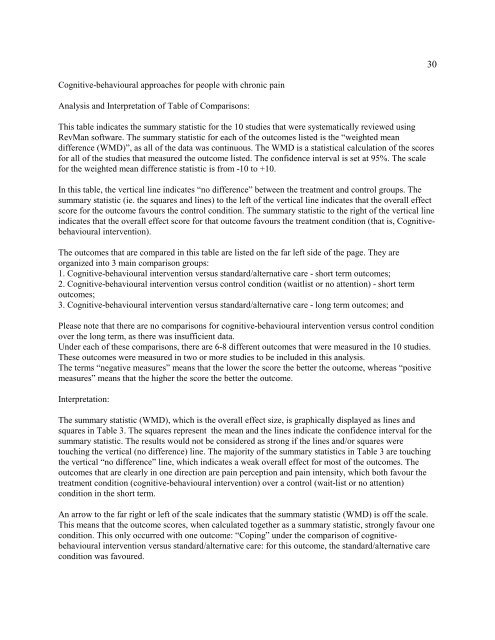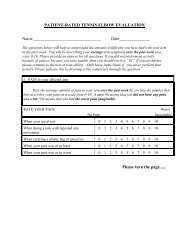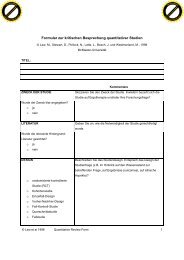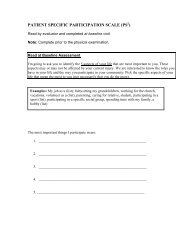The effectiveness of cognitive-behavioural interventions with people ...
The effectiveness of cognitive-behavioural interventions with people ...
The effectiveness of cognitive-behavioural interventions with people ...
You also want an ePaper? Increase the reach of your titles
YUMPU automatically turns print PDFs into web optimized ePapers that Google loves.
30Cognitive-<strong>behavioural</strong> approaches for <strong>people</strong> <strong>with</strong> chronic painAnalysis and Interpretation <strong>of</strong> Table <strong>of</strong> Comparisons:This table indicates the summary statistic for the 10 studies that were systematically reviewed usingRevMan s<strong>of</strong>tware. <strong>The</strong> summary statistic for each <strong>of</strong> the outcomes listed is the “weighted meandifference (WMD)”, as all <strong>of</strong> the data was continuous. <strong>The</strong> WMD is a statistical calculation <strong>of</strong> the scoresfor all <strong>of</strong> the studies that measured the outcome listed. <strong>The</strong> confidence interval is set at 95%. <strong>The</strong> scalefor the weighted mean difference statistic is from -10 to +10.In this table, the vertical line indicates “no difference” between the treatment and control groups. <strong>The</strong>summary statistic (ie. the squares and lines) to the left <strong>of</strong> the vertical line indicates that the overall effectscore for the outcome favours the control condition. <strong>The</strong> summary statistic to the right <strong>of</strong> the vertical lineindicates that the overall effect score for that outcome favours the treatment condition (that is, Cognitive<strong>behavioural</strong>intervention).<strong>The</strong> outcomes that are compared in this table are listed on the far left side <strong>of</strong> the page. <strong>The</strong>y areorganized into 3 main comparison groups:1. Cognitive-<strong>behavioural</strong> intervention versus standard/alternative care - short term outcomes;2. Cognitive-<strong>behavioural</strong> intervention versus control condition (waitlist or no attention) - short termoutcomes;3. Cognitive-<strong>behavioural</strong> intervention versus standard/alternative care - long term outcomes; andPlease note that there are no comparisons for <strong>cognitive</strong>-<strong>behavioural</strong> intervention versus control conditionover the long term, as there was insufficient data.Under each <strong>of</strong> these comparisons, there are 6-8 different outcomes that were measured in the 10 studies.<strong>The</strong>se outcomes were measured in two or more studies to be included in this analysis.<strong>The</strong> terms “negative measures” means that the lower the score the better the outcome, whereas “positivemeasures” means that the higher the score the better the outcome.Interpretation:<strong>The</strong> summary statistic (WMD), which is the overall effect size, is graphically displayed as lines andsquares in Table 3. <strong>The</strong> squares represent the mean and the lines indicate the confidence interval for thesummary statistic. <strong>The</strong> results would not be considered as strong if the lines and/or squares weretouching the vertical (no difference) line. <strong>The</strong> majority <strong>of</strong> the summary statistics in Table 3 are touchingthe vertical “no difference” line, which indicates a weak overall effect for most <strong>of</strong> the outcomes. <strong>The</strong>outcomes that are clearly in one direction are pain perception and pain intensity, which both favour thetreatment condition (<strong>cognitive</strong>-<strong>behavioural</strong> intervention) over a control (wait-list or no attention)condition in the short term.An arrow to the far right or left <strong>of</strong> the scale indicates that the summary statistic (WMD) is <strong>of</strong>f the scale.This means that the outcome scores, when calculated together as a summary statistic, strongly favour onecondition. This only occurred <strong>with</strong> one outcome: “Coping” under the comparison <strong>of</strong> <strong>cognitive</strong><strong>behavioural</strong>intervention versus standard/alternative care: for this outcome, the standard/alternative carecondition was favoured.
















